My Summer EduVacation
By Janlee Wong, MSW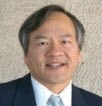
This summer, my family and I had the wonderful opportunity to take a Civil Rights Travel Course led by Dr. Karen McCord, PhD, Solano Community College. The trip has been a dream of my wife Mariko and we were so happy that our two adult daughters were eager to join us.
This year is special because it is the 50th Anniversary of the Civil Rights Act of 1965 and the Selma to Montgomery March. It was an amazing trip and I was deeply moved hearing about the struggle and the power of the nonviolent approached used by Dr. Martin Luther King, Jr. against the extremely violent and murderous Ku Klux Klan (KKK) hate group and their sympathizers.
In the context of this trip, we had the Charleston hate crime murders and the removal of the Confederate battle flag on the state capitol grounds in South Carolina and Alabama. For those who say the flag represents history and heritage, then yes, for many it is the history and heritage of slavery, racism, hatred, violence and murder.
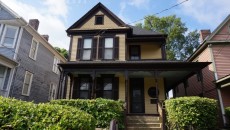 Our journey started in Atlanta and a visit to the King District which included Dr. and Mrs. King’s tomb as well as his boyhood home and the Ebenezer Baptist Church. From Dr. King’s simple beginnings we followed his path to Montgomery, Alabama, when he became pastor at the Dexter Avenue Baptist Church. Throughout the trip, we learned more and more about this remarkable man who moved the consciousness of everyone in the U.S. and the world.
Our journey started in Atlanta and a visit to the King District which included Dr. and Mrs. King’s tomb as well as his boyhood home and the Ebenezer Baptist Church. From Dr. King’s simple beginnings we followed his path to Montgomery, Alabama, when he became pastor at the Dexter Avenue Baptist Church. Throughout the trip, we learned more and more about this remarkable man who moved the consciousness of everyone in the U.S. and the world.
In Montgomery, we learned that the ground work for the civil rights movement had already been laid by 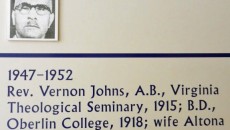 Dr. Vernon Johns. For his time, Dr. Johns was considered a radical who argued for a bus and business boycott to protest Jim Crow segregation. He was so radical that the Dexter Avenue Baptist Church sought out a replacement, Dr. King. Little did anyone realize Dr. King would bring the fight for civil and voting rights to the forefront of the nation’s consciousness.
Dr. Vernon Johns. For his time, Dr. Johns was considered a radical who argued for a bus and business boycott to protest Jim Crow segregation. He was so radical that the Dexter Avenue Baptist Church sought out a replacement, Dr. King. Little did anyone realize Dr. King would bring the fight for civil and voting rights to the forefront of the nation’s consciousness.
Shortly after Dr. King’s arrival in Montgomery, the first African American, 15-year-old Claudette Colvin, refused to move to the back of the bus. It was remarkable that this teenager pushed aside 90 years of post-Civil War Jim Crow 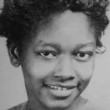 segregationist laws to demand her rights. Ms. Colvin was later asked to step away after she became
segregationist laws to demand her rights. Ms. Colvin was later asked to step away after she became  pregnant.
pregnant.
She was followed by Rosa Parks whose bus boycott campaign was organized by Dr. King and others. Ms. Parks became the national symbol of protest, but we owe Ms. Colvin a debt of gratitude for paving the way.
At the Civil Rights Memorial Center, Southern Poverty Law Center, James Chaney, Andrew Goodman and Michael 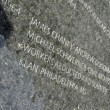 Schwerner are memorialized along with 38 others who gave their lives for the cause. Michael Schwerner, a Columbia MSW, is one of the martyrs of the movement giving his life for social justice. Throughout our tour these three were memorialized everywhere.
Schwerner are memorialized along with 38 others who gave their lives for the cause. Michael Schwerner, a Columbia MSW, is one of the martyrs of the movement giving his life for social justice. Throughout our tour these three were memorialized everywhere.
In Selma, Alabama we walked across the Edmund Pettus Bridge where marchers were severely beaten trying to march to Montgomery on Bloody Sunday. Subsequent marches led by Dr. King were peaceful and no one was hurt. I hope they rename that structure someday and any other place across the country that is named for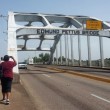 KKK leaders.
KKK leaders.
In Mississippi, we stopped at the ruins of a small grocery store in Money, Mississippi, where 14-year-old Chicagoan Emmett Till went in to buy candy. He was later kidnapped, tortured and murdered for whistling at the store owner’s wife. I hope the store can be preserved so that we will always know that the struggle against racism will never be over. The murderers were acquitted by an all-white jury and the killers admitted their guilt in an exclusive story which they sold to Look Magazine. Emmett’s mother, Mamie, refused to allow him to be quietly buried in Mississippi and brought her son’s body back to Chicago. She ordered the funeral service to be open casket so everyone could see how he was tortured and murdered. Her story was one of the most courageous that I have ever heard.
allow him to be quietly buried in Mississippi and brought her son’s body back to Chicago. She ordered the funeral service to be open casket so everyone could see how he was tortured and murdered. Her story was one of the most courageous that I have ever heard.
While Dr. King and many of his contemporaries were political, they didn’t run for public office as Fannie Lou Hamer did. A pioneer in black political action from Ruleville, Mississippi, Ms. Hamer was the first to challenge the whites-only Democratic Party in Mississippi and eventually at the 1964 Democratic National 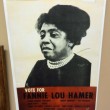 Convention. Hamer said when she volunteered to register to vote: “I guess if I’d had any sense, I’d have been a little scared — but what was the point of being scared? The only thing they could do was kill me, and it kinda seemed like they’d been trying to do that a little bit at a time since I could remember.”
Convention. Hamer said when she volunteered to register to vote: “I guess if I’d had any sense, I’d have been a little scared — but what was the point of being scared? The only thing they could do was kill me, and it kinda seemed like they’d been trying to do that a little bit at a time since I could remember.”
One of the best civil rights museums is the National Civil Rights Museum at the Lorraine Motel in Memphis. Not only is the Lorraine Motel where Dr. King was assassinated well preserved but also the boarding house across the  street where the assassin stayed. He fired the fatal shot from a small bathroom window. Many believe that James Earl Ray could not have acted alone and the exhibit at the boarding house brings up that very question.
street where the assassin stayed. He fired the fatal shot from a small bathroom window. Many believe that James Earl Ray could not have acted alone and the exhibit at the boarding house brings up that very question.
When I was in Memphis, I was happy to hear that the city government was going to move the KKK Co-founder and Confederate General Nathan Bedford Forrest statue and grave from public property. Forrest was 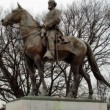 also accused of allowing war crimes in the murder of hundreds of black Union POWs and their white officers.
also accused of allowing war crimes in the murder of hundreds of black Union POWs and their white officers.
In Birmingham, Alabama, we visited the 16th St. Baptist Church and I still can’t imagine that someone would kill the four little girls Addie Mae Collins, Cynthia Wesley, Carole Robertson and Carol Denise McNair with a bomb. I am thankful the perpetrators were finally prosecuted but sad that it took 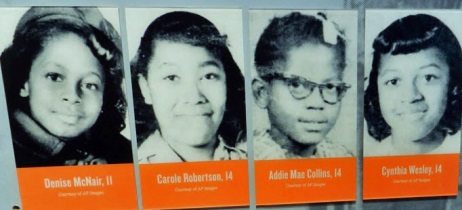 decades for justice to be served. You can still feel the sorrow when you see their memorials in Birmingham.
decades for justice to be served. You can still feel the sorrow when you see their memorials in Birmingham.
I knew the racist Birmingham Public Safety Commissioner Bull Connor ordered the police, firemen and dogs to attack protestors in 1963, having watched the violent scenes on black and white TV. What I didn’t know was they were attacking school children. Connor arrested and jailed more than 3,000 mostly children, some as young as 4 years old.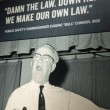
When we stopped in Anniston, Alabama, at the sites of incredible violence against the Freedom Rider buses, I was moved by Dr. Baker’s story of being savagely beaten by whites for sitting in the Whites Only section of the bus station. I asked him if anyone in Anniston ever apologized to him. He said no. Then a voice spoke up from the back of the room. A white man was passing by our room and heard the story. He said he was from Anniston and he wanted to apologize to Dr. Baker. He went up to him and they shook hands.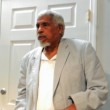
While this is only a glimpse into my civil rights journey to the south, I’m glad it ended on such a positive note in Anniston. Acknowledgement and apology are the first steps toward reconciliation. I recommend everyone take a bus ride through the South to really see and feel what it was like.











